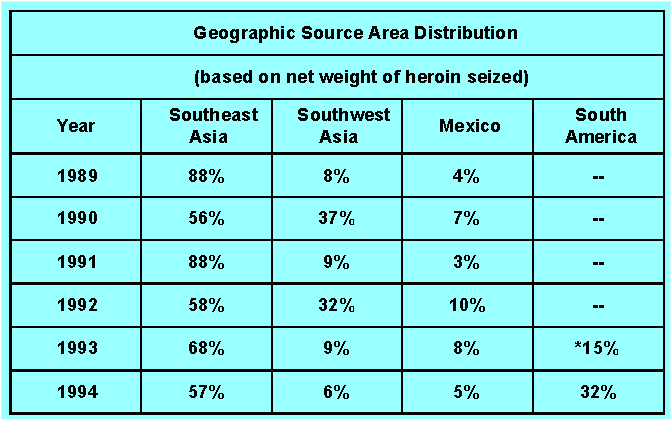![]()
 DEA Press Release
DEA Press Release
Almost One Third of Heroin Seized in the United States Originates in South America
South American (primarily Colombian) heroin production now accounts for a startling 32% of
heroin seized domestically in 1994. According to DEA Administrator Thomas A. Constantine, "Just
5 years ago, almost all of heroin seized came from Asia. Today, 32 percent of heroin
seized can be traced to South America, with an estimated 20,000 hectares of opium poppies
being cultivated in Colombia alone. Colombian traffickers have diversified into heroin and
this is no accident -- it's a shrewd marketing decision made to capitalize on the
increased profits that can be derived from heroin trafficking. And unless checked,
Colombian drug traffickers will be poised to become central players in the Western
Hemisphere heroin market in the next decade."
These figures are based upon DEA's 1994 Heroin Signature Program (HSP) test results
completed in May 1995. Each year an in-depth chemical analysis is performed on 600 to 800
samples taken from heroin seizures and purchases made in the United States. As a result of
the signature analysis, DEA chemists are able to associate the heroin sample with a heroin
manufacturing process unique to a geographic source area. During 1994, 790 seized samples
underwent signature analysis at DEA's Special Testing and Research Laboratory in McLean,
Virginia.
DEA Administrator Constantine stated that "In 1991, South American heroin
production and seizures were insignificant. In just one short year, South American heroin
accounted for 15% of HSP seizures, and by 1994 the percentage had more than doubled to 32
percent. That staggering growth and market share would unfortunately make a perfect case
study for the Wharton School of business."
DEA's Domestic Monitor Program (DMP), which tracks price, purity and availability through
analysis of street level purchases also points to an increase in the availability of South
American heroin. The DMP shows an increase in the amount of Colombian heroin available,
particularly in the northeastern United States. During 1994, South American heroin
accounted for almost 7 of every 10 DMP purchases in Boston, Newark, New York City and
Philadelphia, with an average purity of 59 percent.
In another indicator, DEA's El Paso Intelligence Center (EPIC) reports an almost 6-fold
increase in the number of Colombian couriers who were arrested smuggling heroin into the
United States in the 2-year period from 1991 to 1993.
"Data collected in hospital emergency rooms, police departments, courts, schools,
treatment programs and on the street show tragically that heroin consumption in the United
States is on the rise. Heroin has become more affordable. We are seeing more people
smoking heroin, or heroin use coupled with crack or other forms of cocaine, and we are at
risk of developing a younger generation of heroin addicts." Administrator
Constantine added, "With the street level at the highest level its ever been
(averaging 40% nationwide) we're looking at a serious problem. America already has an
estimated 600,000 hard core heroin addicts. This should be a wake-up call for all
Americans."

Travel back to the DRCNet Response to the DEA Home Page
Travel back to the DRCNet Response to the DEA Press Release List